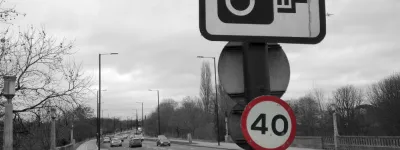In the 1920s and 30s, miles and miles of new roads were built around the fringes of London in one of the biggest roadbuilding booms the UK has ever seen. They were designed to speed traffic around historic bottlenecks and open up new land for development, and even today the Arterial Roads built in that era form the backbone of the road network in many parts of the city.
Most of them are famous (and quite a few of them are downright notorious). Western Avenue, the Great West Road and the North Circular Road are well known to everyone. The A127 Southend Arterial Road actually has "Arterial Road" in its name. Others, like the Barnet Bypass or Sutton Bypass, might be less well known.
There are a few, however, that are almost completely forgotten — so much a part of the furniture that you might have to look closely to realise that they weren't always there, or perhaps so small and unexpected that you'd never think they were once part of a thrilling programme of new roads.
This feature takes a look around London and ignores the grand thoroughfares of the thirties to take a look at some of the more obscure creations of the pre-war era: London's forgotten Arterial Roads.
Greenford Road
It's now largely built-up and looks like many other suburban main roads, but its width gives it away: not only is it reasonably wide, with broad pavements and a road surface capable of carrying four lanes of traffic (even if many parts are not marked out that way), it's precisely that wide all the way from Uxbridge Road to Sudbury Hill. Normal roads, that developed over time, rarely have a consistent width; new roads built from scratch are much more orderly.
Where the Central Line crosses the road, the arched viaduct is actually even newer than Greenford Road itself: the tube didn't start running here until 1947. Behind it is another, lower railway bridge carrying an ordinary railway line. Both bridges clear Greenford Road in one single span of precisely 60 feet.
It might now be built up and not as fast as it used to be — you can bet that very little of it had a 30mph limit when it first opened — but Greenford Road is still the fastest route north and south in these parts, and still does what one suspects it was meant to do: connect suburbs in the vicinity of Harrow and Southall to the thrilling Western Avenue.
Bridgewater Road
The part called Bridgewater Road really is new, and runs parallel to the Piccadilly Line to bypass Wembley town centre. From Alperton to Hanger Lane Gyratory, existing roads were widened and straightened to the same standard as the new section to continue the smooth ride all the way to Western Avenue.
This means that Bridge Street in Molesey is now a quiet shopping street and no longer leads over the Thames. It also means that the new bridge leads directly onto a road that didn't exist before: the A309 Hampton Court Way.
The road itself should be familiar enough by now: broad, straight, with grass verges and footpaths on either side. Its width is not just consistent but also one of those nice, round numbers that inter-war roadbuilders liked so much: 80 feet (24m), just like Bridgewater Road.
Spur Road, Isleworth
The reason it exists is because, at its southern end, it leads directly into the A310 Twickenham Road. Back in 1925, that was the main road towards London from Twickenham and other parts of Surrey. Without a connecting spur to the new Great West Road, all that traffic would continue to travel the old road through Brentford.
As well as the shortest and narrowest Arterial Road here, it may also be the most disposable. In 1933 the Great Chertsey Road was opened, forming a direct route from Twickenham and Richmond to London, and after just eight years' service Spur Road was no longer the main road to anywhere.
You might think that the story would end there, but because Charter Way was built as part of the Arterial Roads programme, it held a strange fascination for cartographers for decades afterwards. Even though it had become just a road between two arms of a junction, fronted by some 1930s flats and a synagogue, it continued to be specially marked on road maps of London as an "Arterial or Bypass Road" long after it should have faded to obscurity.
It might not be much of a ride today, but if you get a chance, turn left at Henlys Corner and take a trip on Charter Way — one of London's forgotten Arterial Roads.
Picture credits
Extracts from the following maps appear in this article:
- Geographia Two-Sided Road Map of London and SE Coast backed by 12 Miles Round London (undated, but from various incomplete Arterial Roads is circa 1928)
- Geographia "Up-to-date Road Map of Kent" (undated, but the Great Chertsey Road is shown so it is post-1933)
- Daily Mail Motor Road Map of South East England and Motor Road Map of London and 10 Miles Around (1946)
- Esso Road Map No. 1 London (undated, but shows the Barnet Bypass as A555 so it is pre-1954)
- Dunlop "Motoring About London" 3rd Extended Edition (undated, but shows the M4 Brentford Viaduct so is post-1965)
